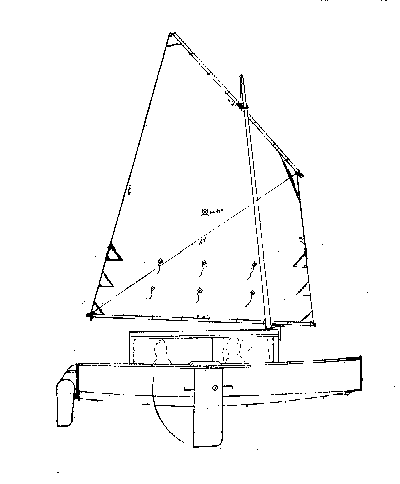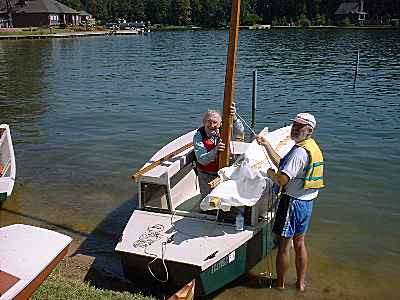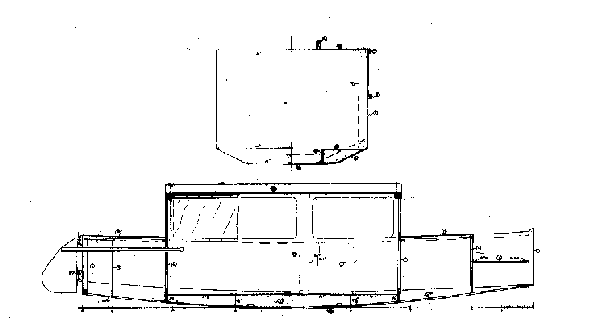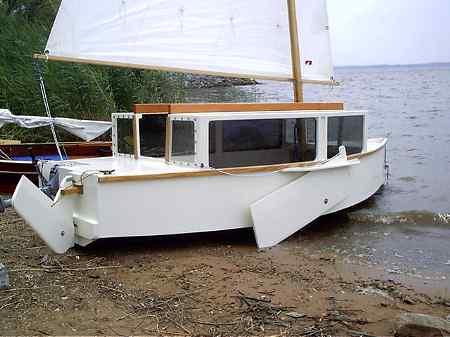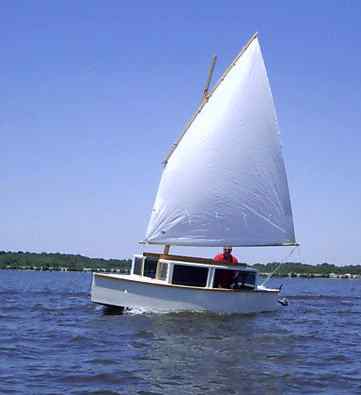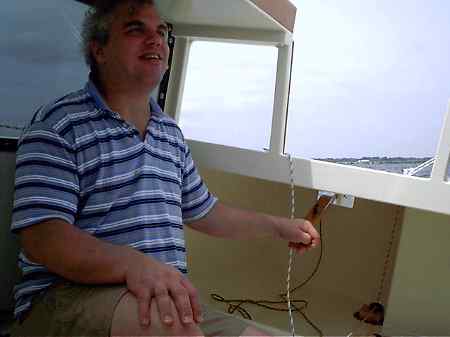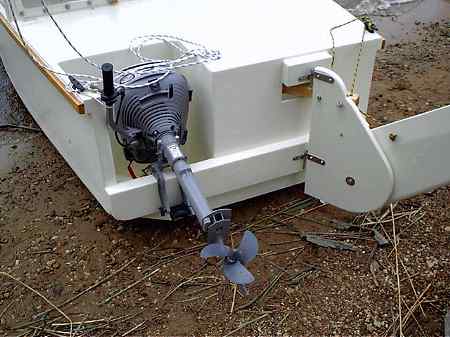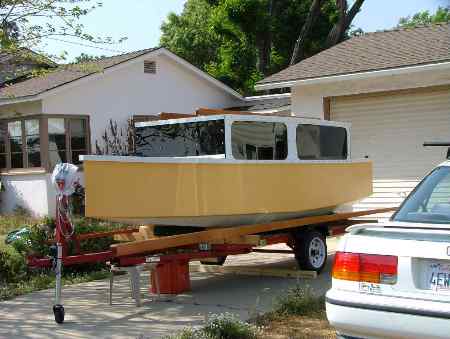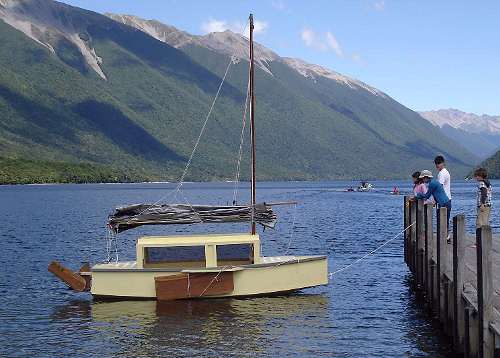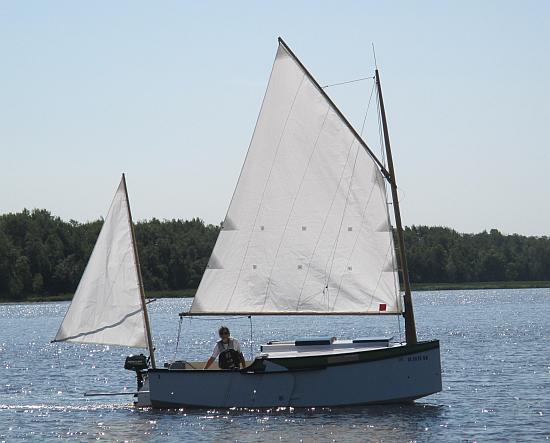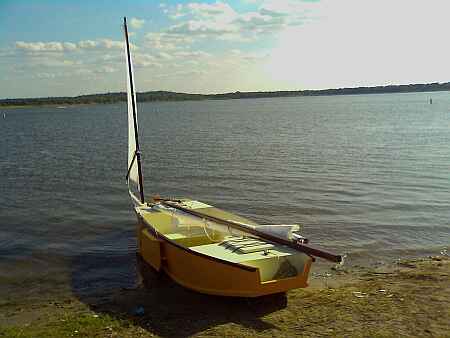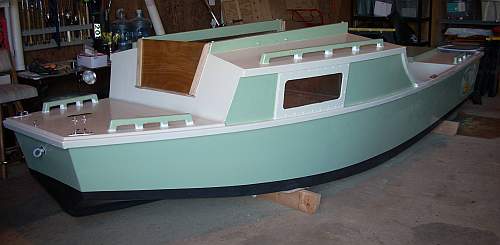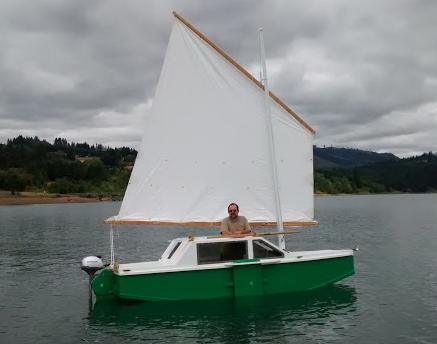Jim Michalak's Boat Designs
1024 Merrill St, Lebanon, IL 62254
A page of boat designs and essays.
(15 September 2019) We go Scram Pramming in Canada with Bob Ennenberg. The 1 October issue will keep us in Canada for some OliveOyling.
THE BOOK IS OUT!
BOATBUILDING FOR BEGINNERS (AND BEYOND)
is out now, written by me and edited by Garth Battista of Breakaway Books. You might find it at your bookstore. If not check it out at the.... ON LINE CATALOG OF MY PLANS......which can now be found at Duckworks Magazine. You order with a shopping cart set up and pay with credit cards or by Paypal. Then Duckworks sends me an email about the order and then I send the plans right from me to you.
 | Left:
Bob Ennenberg wrote a wonderful letter about his Scram Pram "Duck" in British Columbia. |
|
Scram Pram In British Columbia
Hi Jim.
In 2009, I finished building my Scram Pram. We named her Duck and we’ve been enjoying her ever since. I’d like to update you on her adventures and send you a few pictures.
My intrepid wife and I have had some great cruises in her, including some pretty distant destinations thanks to our ability to trail her where we want to go, then launch and sail. We just came home from another beautiful week. We started very ambitiously with a plan to sail 12 miles in the open Pacific to the Broken Islands but the forecast 15- to 25-knot winds sent us to the more protected waters of Clayoquot Sound.
We got kind of damp there in the rain, so we pulled the boat out and trailed to the other (east) coast of Vancouver Island, where we finished our trip in warm, dry weather and 5-10-knot winds. The beautiful, sculpted rock formations above are on the west side of Valdes Island. That’s the beauty of this design: we can go where the weather’s good (by ferry if necessary—as in the photo below), unlike bigger boats that have a short range and have to stay put and wait for the weather to change.
Another advantage: our shallow draft means we can find space in just about any harbour, just inshore from the other small boats. On this trip, I woke up one morning to find our rudder tip 6 inches from the muddy bottom! That would have been scary in a keelboat but in the Duck we can actually plan for that kind of depth.
We used that range on other trips too, including one to the Broughton Archipelago three years ago. After we launched, the owner of a big keelboat asked how long it took us to get there. When I told him it took one day, he laughed. He’d started in our home town and sailed for twelve days! We saw humpback whales on that trip.
We love the protected feeling of sailing this boat in stronger winds and waves. With all 3 ballast tanks full of water and 2 reefs in the sail, Duck can handle some major weather. During an early October trip few years ago, the northwest wind got close to 20 knots, with waves up to 3 feet high. With ballast and reefs, we bounced to our destination slightly damp (Duck has a Plexiglas front window with weather-stripping to block the forward opening) but nothing broke and we never felt in danger.
I made a few minor changes to the design. I sheet the sail with a double-ended mainsheet, through a double block at the rear transom. I have 2 cam cleats for the mainsheet on the aft entrance to the cabin—one on each side so I can sit between them. This way, steering feels light and easy because the sheet isn’t pulling on it. Sheeting is easy from either side when I’m sitting in the cabin or in the companionway.
I didn’t cut out the forward transom to make a step. Instead, I put a lid on it and we use it for an anchor locker. Our 15-pound Danforth is heavy for such a small boat but it has never dragged, even when we give it less scope than we should.
I added a hefty 4-to-1 downhaul to help reduce twist and I’m experimenting with a backhaul to keep the boom from sliding forward when sailing upwind. I’d like to improve our tacking angle, which seems stuck around 120 degrees.
I covered the forward and after decks with a very thin layer of glass cloth set in epoxy, then I varnished it. The bright areas really improve the look of the boat! I wish I’d done the same with the cabin tops—they’re not strong enough to walk or sit on, even though I added a crossbeam halfway back under each side. I may glass them lightly in future.
I added light-weight bug screens to fill both entrances. They Velcro onto the wood and to the canvas cover. Then we roll them up when not needed and they take no space at all. We plug the tiller-entrance hole with a rag. The ventilation is great with both screens installed.
I improvised a simple boarding ladder by hanging a loop of rope over the stern with a 6-inch piece of PVC pipe in it for a step. I hung a length of rope from the mainsheet block so we can hang onto it as we climb aboard. Works like a charm! The rope stays put when you step in it because it just barely extends below the transom. You do have to be flexible enough to raise your foot to the bottom edge of the transom.
When we cruise, we keep food, cooking gear and sleeping bags under the forward deck. We cook on the forward deck, use the starboard cabin top as a serving table, and rest comfortably on thick cushions in the cabin. Cooler, water jug and porta-potty live in the cabin while all boat parts, ropes and navigation stuff live under the after deck. I keep charts, GPS and nav books in a big waterproof box under the tiller. We carry flares, a VHF radio, a fire extinguisher, and even battery powered running lights in case we get caught out after dark. We’ve never used those. Getting stuff into and out of the storage spaces gets more taxing as we age (both 62 now) but we’re willing to do it for a while yet.
What’s next for the Duck? We keep thinking about a trip north to sail down the east coast of Haida Gwaii and visit the ancient indigenous villages with their collapsed longhouses and old totem poles. Or maybe Baja. Or maybe just back to our warm, lovely Gulf Islands or a local lake. So many choices!
Thanks for this great design. Everywhere we sail, people ask a million questions and are impressed by the things our little Duck can do. And sailing her is a joy!
Bob Ennenberg Vancouver, British Columbia
Philsboat
PHILSBOAT, SAILBOAT, 15' X 5.5', 550 POUNDS EMPTY
Philsboat is essentially an IMB with the nose extended to a pointy bow. The width and multichine configuration are the same as IMB's. The cabin is 3" deeper because Phil is at least 3" taller than most of us. In a boat with a Birdwatcher cabin like this one added depth to the cabin makes it safer in that the righting forces in a knockdown are greater. That would be true of any boat if the center of gravity did not move with the cabin roof but with the normal cruiser adding depth to the cabin also means raising the crew deck up so the folks can see over the raised cabin. And that means the CG is elevated too, and then all bets are off concerning self righting. But with a boat like Philsboat eveyone rides down low inside looking out through the windows.
Here is a photo of Bob Williams' IMB:
In addition to the pointy bow and added headroom I added what I hope is a serious motor mount. Probably 3hp will drive it as fast as it will ever go and that at part throttle. But the motor well gets to looking pretty large even for such a small motor. For one thing it must be deep to put a short shaft motor on a deep stern like this so I ran it straight down to the boat's bottom. Working on the motor down it its well will be about impossible and you might need to keep an eye on your knuckles when you pull the starting rope. And the well must be surprisingly wide to allow the motor to swivel in steering although the usual case here will be to keep the motor locked straight ahead and steer with the tiller. The wide well pushed the rudder off center and you need a crooked tiller or rudder linkage to make it all work. I opted for a simple but crooked tiller.
I also added low seats like those I saw added to the two IMB's that came to the Lake Conroe Messabout. Pretty much the same as what I have in Scram Pram where the seats do double duty as water ballast tanks. Philsboat seats could easily be converted into water ballast tanks also but the IMB capsize tests imply the ballast isn't needed.
The sail rig uses a balanced lug, 113 square feet and the same as that of a Bolger Windsprint.
Philsboat uses taped seam construction. Five sheets of 1/4" plywood, five sheets of 3/8" and three sheets of 1/2" plywood.
Actually the size and material list for Philsboat are about the same as that of Scram Pram. So which boat would be better? Take Philsboat if you are a pointy bow guy. It should be better in really rough water. On the other hand Scram is wider and roomier. It has a flat step through bow that will splash and spit in rough water but makes beaching a very nice experience.
Update, 2007. Chris Feller completed his Philsboat, probably the first prototype completed, and brought it to the 2007 Rend Lake Messabout. Very well made and to plans except he used the 91 sq ft lugsail he had on hand for his AF3, with some mast rake changes he calculated with his "sail area math". Sailed correctly rigtht off the drawing board, so to speak. We had a chance to use it for a few really nice days. In a good sailing breeze, say 10 to 15 knots with occasional whitecaps, our gps bobbed between 5.5 and 6mph for two hours of reaching as we crossed back and forth on the big lake. When I used the Philsboat I thought it was probably just as easy to enter from a beach as the blunt bowed Scram. The front deck is about 2' high so you can sit on it and swing you legs around onto the deck and then into the cabin.
Chris is a big boy but there was plenty of room inside for the two of us and more. Rumor has it that at the campsite the night before Chris slept in the Philsboat on the trailer with an airconditioner in the front hatch plugged into the campsite power. So the boat is plenty big in the way most people would use it.
The stern layout has the motor in a small well to one side and the rudder offset to the other side to give the motor room to swing. There is no linkage to the tiller, the tiller is simply "unstraight" so that is falls on centerline at the skipper's hand. Seems to work well and is quite simple. Chris uses a 2hp Honda which has a fairly large cowling for its size and must be rotated 180 degrees to grab reverse. He said the motor well size is a bit too small for that. Karl James had the same problem with his Jewelbox a long time ago and simply cut away the side of the hull in top of the motor well region - after all it is just there for looks. Chris said he tried the boat under power and found it went 6 mph max, just like under sail. No surprize to me. My Birdwatcher also maxes out at 6mph under 3hp and under 5.5 hp. This sort of hull will only go so fast. Add more power and you just dig a deeper hole and make a bigger wake - you won't go faster. But sometimes more power is nice on a windy day.
(As an update, Chris has brought his Philsboat to several more Rend Lake meets. In 2008 the meet was very windy and Philsboat got a full windows wet knockdown with Chris and Tom Hamernik on board. She self righted with no issues and they kept right on sailing, but Chris confessed he has 100 pounds of lead shot under the seats. Also he is using a 3hp vintage Johnson which he says is quieter and smoother than the Honda.)
You might recall from the Prototypes section recently that there was another Philsboat being built in California. That one last I heard was about to be launched. Has more changes from blueprint than Chris's boat but still is pretty true to form. Seems to be known as Bumble and made by Rex Meach.
And in New Zealand Rob Kellock has been sailing his with a junk rig. He has been knocked down a couple of times and self righted as planned:
Plans for Philsboat are $45.
Prototype News
Some of you may know that in addition to the one buck catalog which now contains 20 "done" boats, I offer another catalog of 20 unbuilt prototypes. The buck catalog has on its last page a list and brief description of the boats currently in the Catalog of Prototypes. That catalog also contains some articles that I wrote for Messing About In Boats and Boatbuilder magazines. The Catalog of Prototypes costs $3. The both together amount to 50 pages for $4, an offer you may have seen in Woodenboat ads. Payment must be in US funds. The banks here won't accept anything else. (I've got a little stash of foreign currency that I can admire but not spend.) I'm way too small for credit cards.
We have a Picara finished by Ken Giles, past Mayfly16 master, and into its trials. The hull was built by Vincent Lavender in Massachusetts. There have been other Picaras finished in the past but I never got a sailing report for them...
And the Vole in New York is Garth Battista's of www.breakawaybooks.com, printer of my book and Max's old outboard book and many other fine sports books. Beautiful job! Garth is using a small lug rig for sail, not the sharpie sprit sail shown on the plans, so I will continue to carry the design as a prototype boat. But he has used it extensively on his Bahamas trip towed behind his Cormorant. Sort of like having a compact car towed behind an RV.
And a Deansbox seen in Texas:
Another prototype Twister is well along:
A brave soul has started a Robbsboat. He has a builder's blog at http://tomsrobbsboat.blogspot.com. (OOPS! He found a mistake in the side bevels of bulkhead5, says 20 degrees but should be 10 degrees.) This boat has been sailed and is being tested. He has found the sail area a bit much for his area and is putting in serious reef points.
AN INDEX OF PAST ISSUES
THE WAY BACK ISSUES RETURN!
MANY THANKS TO CANADIAN READER GAETAN JETTE WHO NOT ONLY SAVED THEM FROM THE 1997 BEGINNING BUT ALSO PUT TOGETHER AN EXCELLENT INDEX PAGE TO SORT THEM OUT....
THE WAY BACK ISSUES
1oct18, Plywood Butt Joints, Larsboat
15oct18, Small Boat Rudders, Jonsboat
1nov18, Sink Weights, Shanteuse
15nov18, Piccup Spinoffs, Piccup Pram
1dec18, Electric Boats 1, Ladybug
15dec18, Electric Boats 2, Sportdory
1jan19, Sail Area Math, Normsboat
15jan19, AF3Capsize, Robote
1feb19, Bulkhead Bevels, Toto
15feb19, Leeboard Issues, IMB
1mar19, Hollow Spars, AF4 Breve
15mar19, Underwater Board Shape, Harmonica
1apr19, Polytarp Sails 1, River Runner
15apr19, Polytarp Sails 2, Mayfly16
1may19, Sail Shaping, Blobster
15may19, Sail Shaping 2, Laguna
1jun19, Capsize Lessons, QT Skiff
15jun19, Rend Lake 2019, Mixer
1jul19, Scarfing Lumber, Vireo14
15jul19, Rigging Lugsails, Vamp
Table of Contents





